
Mantineia Ancient theater
Ancient Iraea near Ayios Ioannis
Loutra Iraeas near the Ladonas bridge has sulphur springs which may have been popular in antiquity. Very good mosaics are present in what used to an ancient bathhouse, in an area known also as Liadora.http://arcadia.ceid.upatras.gr/hraia/genika/hraiaen.html
Megalopolis


Orchomenos

http://odysseus.culture.gr/h/3/eh355.jsp?obj_id=2634
Ancient Asea or Sapiko, near Sapolivado

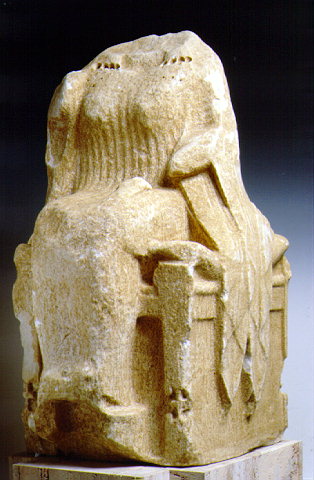
Ancient Brasiae near Agios Andreas
This may be the site of Ancient Brasiae or Brasias with remains of a very ancient acropolis lying on the hill above Agios Andreas, with ruins from Palasgian times. Graves from different periods are also present.
Ancient Dipaea, Piana
Near the village of Piana where the waters of the Elisson or Davia River run, there are remains of the ancient city of Dipaea. There's also a medieval castle.
Ancient Lykosoura

The remains at Lykosoura.


Overlooking the plain of Megalopolis, Lykosoura is a very ancient holy city with remains from temples dedicated to Despoina, Demeter and the Great Mother, one dating from the 4th century BC.
Ancient Mantineia, Gourtsouli Hill


Tomb of Epaminondas


Ancient Methydrion, Petrovouni



Ancient Nestani



Elliniko near Ano Karyes
The plateau of Elliniko on Mount Lykaion features remains of a stadium and hippodrome where the Lycaean games in honour of Zeus took place. There are also remains of a shrine to Pan.
Kaphyes (Kafyes), Mantineia
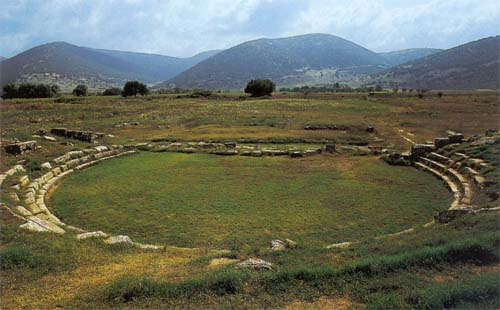
mantineia ancient theater
Leonidi remainsAt the village of Leonidi there are remains of an ancient acropolis and Pelasgian walls at the hill above the town, around the churches of Agios Athanasios (11th century) and Agios Dimitrios (12th century).
Mycenaean Cemetary, Palaiokastro

In a small hill near the village Palaiokastro Gortynias, accidentally revealed large and important cemetery of the Mycenaean period. Originally excavated in 1955 two Mycenaean tombs. The excavations were resumed in 1979 by the Superintendent of Antiquities T. Spyropoulos and lasted 12 years.
The excavations have brought to light about 100 carved tombs of various types (arched, chambered, freatoeideis, pit and kivotoschimoi). Also discovered, and a devotional and ritual construction purpose deemed served as Oracle of late Mycenaean period. The necromancy is considered as the oldest and unique Mycenaean Oracle of ancient Greece. The rich finds of the cemetery exhibited at the Museum of Tripoli.
Around 100 rock-cut tombs of different types (chambers, tholoi, pit-graves, well-shaped graves, etc.) and a temple for religious ceremonies have been uncovered here from the late Mycenaean era, matching Homeric texts about Necyia in the Iliad. The sites artefacts are at the Archaeological Museum of Tripoli.
Sanctuary of Alea Athena, Tegea


Tegea
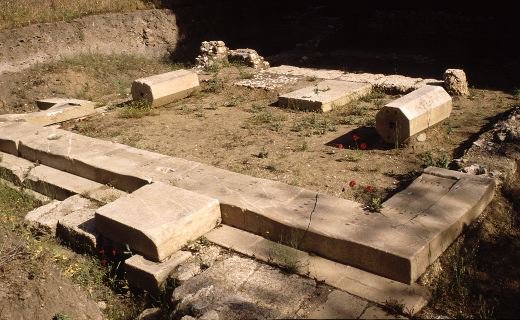
agora in tegea
Excavations have revealed parts of a theatre from the Hellenistic period (175 BC), an agora from the Hellenistic and Roman period, two early Christian basilicas (5th-6th century AD), amazing mosaic floors and parts of a Byzantine settlement (10th-13th century AD). In the middle ages the area was called Nikliou.Steno and Agiorgitika, in Steno
Four metallurgic kilns were from around 1700 BC, and interestingly from the Roman period as well have been revealed at the site, used for melting and improving copper ores. In Roman times the kilns were probably used to remelt metal scrap.
Tavia at Mount Mainalo
The medieval town of Tavia boasts remains of buildings and a castle, supposedly built with stones from Dipaia, a more ancient site.
Vigla
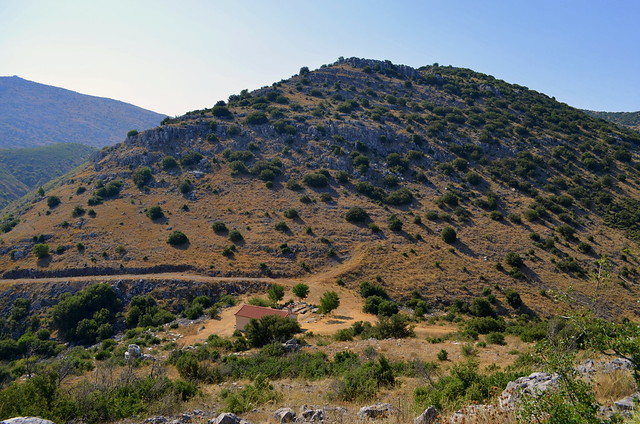

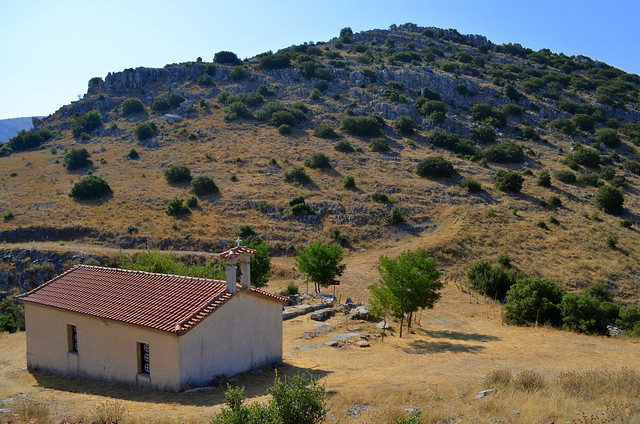

Teuthis

Teuthis (Ancient Greek: Τεύθις) was a city in ancient Arcadia. It was part of the region of Orchomenus.[1] It was abandoned when Megalopolis was founded. There were sanctuaries of Athena, Aphrodite and Artemis in the town.[2] It was in the location of modern Dimitsana.[3]
Its residents participated in the Trojan War under a general who was named Teuthis or Ornytus. When the Greeks were stuck in Aulis because of unfavourable winds, Teuthis fought with Agamemnon and decided to return home with his army. The goddess Athena appeared in the form of Melas and tried to dissuade him, but he would not change his mind; he was outraged and hit the goddess in the thigh with a spear. He then did return home but not much later, he dreamt of Athena with a wound in her thigh; the goddess punished him with an incurable headache and struck Arcadia with famine. Later, the city residents visited the oracle of Dodona and accordingly built the statue of Athena with a bandage on the thigh as an appeasement.
The ancient acropolis has been excavated, and several ancient buildings have been found scattered throughout the town Dimitsana.
Lykaia wolf-Zeus Mount Lykaion




In Ancient Greece, the Lykaia (Greek: Λυκαία) was an archaic festival with a secret ritual on the slopes of Mount Lykaion ("Wolf Mountain"), the tallest peak in rustic Arcadia. The rituals and myths of this primitive rite of passage centered upon an ancient threat of cannibalism and the possibility of a werewolf transformation for the epheboi (adolescent males) who were the participants. The festival occurred yearly, probably at the beginning of May.
The epithet Lykaios ("wolf-Zeus") is assumed by Zeus only in connection with the Lykaia, which was the main Arcadian festival. Zeus had only a formal connection as patron of the ritual. In the founding myth, of Lycaon's banquet for the gods that included the flesh of a human sacrifice, perhaps one of his sons, Nyctimus or his grandson, Arcas, Zeus overturned the table and struck the house of Lyceus with a thunderbolt;[6] his patronage at the Lykaia can have been little more than a formula. Long afterward, in the late 3rd century CE, the philosopher Porphyry reported that Theophrastus had compared the sacrifice "at the Lykaia in Arcadia" with Carthaginian sacrifices to Moloch.
The ritual was nocturnal, to judge from the name of Nyctimus (nyx, "night") that was given to the son of Lycaeus who was killed and served up as part of the feast to Zeus. Rumors of the ceremony that circulated among other Greeks revolved around the theme of human sacrifice and cannibalism: according to Plato, a particular clan would gather on the mountain to make a sacrifice every nine years to Zeus Lykaios, and a single morsel of human entrails would be intermingled with the animal's. Whoever ate the human flesh was said to turn into a wolf, and could only regain human form if he did not eat again of human flesh until the next nine-year cycle had ended. The traveller Pausanias told of an Olympic boxing champion Damarchus of Parrhasia, who had "turned into a wolf at the sacrifice to Zeus Lykaios, and changed back into a man again in the ninth year thereafter", from which Walter Burkert affirms that, for Damarchus to have successfully participated at least nine years later, the participants in the ritual feast must have been ephebes.
There were several sites. At the summit on Mount Lykaion Pausanias saw the ash-pile altar to Zeus[12] but, as attending the rite was impossible, he was obliged to "let it be as it is and as it was from the beginning".
Near the ancient ash-heap where the sacrifices took place was a forbidden precinct in which, allegedly, no shadows were ever cast. Anyone who entered would have to be sacrificed. There was the cave of Rhea, the Kretaia, where, according to local legend, Zeus was born and was cared for by the nymphs. There were games associated with the satisfactory completion of the Lykaia, which removed in the 4th century to Megalopolis; when it was founded in 371 BCE, Megalopolis was the first urbanization in rustic Arcadia; there the major temple was dedicated to Zeus Lykaios, though the Arcadians continued to sacrifice on the mountain-top to Pausanias' day (2nd century CE).
Modern archaeologists have found no trace of human remains among the sacrificial detritus, but recent discoveries at the mountain-top ash-heap altar that Pausanias saw but was reluctant to pry into, reveal that it was much older than the Classical Greeks themselves realised. Early 20th century excavations at the site had revealed nothing earlier than ca. 700 BCE, but the Greek-American interdisciplinary Mt. Lykaion Excavation and Survey Project excavated a trench and detected ritual presence at the site at the beginning of the third millennium BCE, a thousand years before Zeus was worshiped in Greece. A Late Minoan rock crystal seal bearing the image of a bull was a notable surprise.
http://arcadia.ceid.upatras.gr/arkadia/archsites/xwroi/lykdias.htm
Ancient Gortis





The archaeological site of Ancient Gortyn located on the right bank of the river Lucius, a magical location at the exit of the gorge. It is road accessible from the Greek villages (6 mm) and Atsicholos (4 mm), and from the Abbey Baptist.
Ancient Gortyn was an important city of Arcadia in ancient times. Even today its ruins are still elkoyn The endiaferon and The admiration of visitors, combined with the natural beauty and tranquility. According to the mythology built by Gortys, son of Stymfiloy and great grandson of King Arcadia. From The founder took its behalf by the city and their o Loysios potamos, who from ancient Gortyn to the contribution of its Alpheus onomazetai Gortynios potamos. The city had a temple of Asklepion, large spas - both famous throughout the Peloponnese - two strong fortifications (citadels), other temples and public buildings. The spa here was directly connected with the cult of Asclepius. Ruins of the Temple of Aesculapius, the facilities of the baths and the portico and a citadel 4-6 rows of stones and fragments of towers. In the excavated area of the baths clearly seen, the central hall of the baths with three arches and west and south of the auxiliary spaces. Also within and outside the ochyromatkous surrounds are remains of public buildings, shrines and homes. Easy access is only Asklipieio
Temple of Aphrodite Erycina


The city was said to have been renamed "Psophis" by Echephron and Promachus, two sons of Heracles, who are said to have come from Sicily, and who named the town after their mother, Psophis.
The city, while still called "Phegia", was celebrated as the residence of Alcmaeon, who fled here from Argos after murdering his mother. Here Alcmaeon married Arsinoe (named Alphesiboea in some versions), daughter of Phegeus. In consequence of their connection with Alcmaeon, the Psophidians took part in the second expedition against Thebes, and refused to join the other Greeks in the Trojan War.
In the 2nd century, Pausanias saw at Psophis a ruined temple of Aphrodite Erycina, heroa of Echephron and Promachus, the tomb of Alcmaeon, and near the Erymanthus a temple sacred to that stream. In the early 19th century, William Martin Leake also noticed a part of a theatre unmentioned by Pausanias, on the side of a hill. Nine hundred feet upstream from the junction of the two rivers, and near the walls on the bank of the Erymanthus, Leake also found some remains of a public building, 96 feet in length, below which there is a source of water in the bank. He conjectured that they may be the remains of the temple of Erymanthus.
Psophis was about two miles in circumference. The town walls followed the crest of the ridge to the north, and the bank above the two rivers on the opposite side; and at least up through the 19th century they were traceable nearly throughout the entire circuit of the place. On the north-eastern side of the town, which is the only part not protected by the two rivers or by the precipices at the back of the hill, there was a double enclosure surrounding the citadel, although this has since entirely disappeared.
At a distance of 30 stadia (roughly 3.4 miles) from Psophis was the Seirai (Σείραι), which Pausanias describes as the boundary of the Psophians and the Cleitorians. On the road from Psophis to Thelpusa lay Tropaea, upon the left bank of the Ladon River, near which was the grove Aphrodisium, after which came a column with an ancient inscription upon it, marking the boundaries of Psophis and Thelpusa.
http://arcadia.ceid.upatras.gr/arkadia/places/nesta.htm
http://arcadia.ceid.upatras.gr/arkadia/archsites/archsites.htm



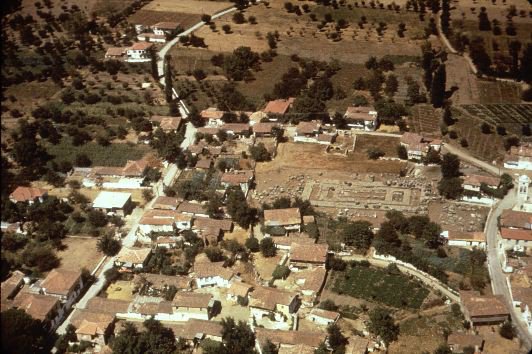
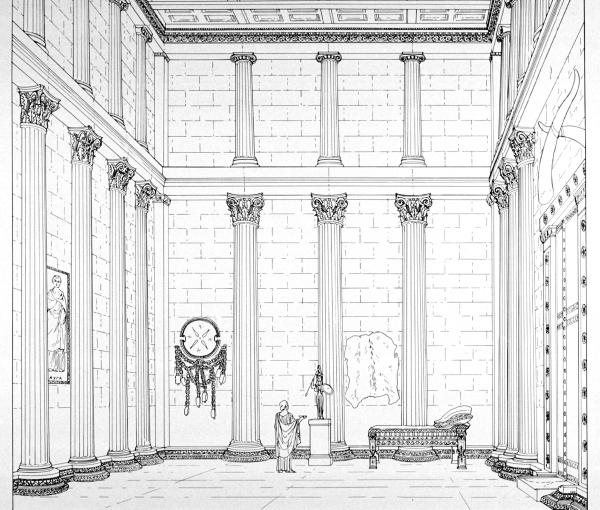
Δεν υπάρχουν σχόλια:
Δημοσίευση σχολίου